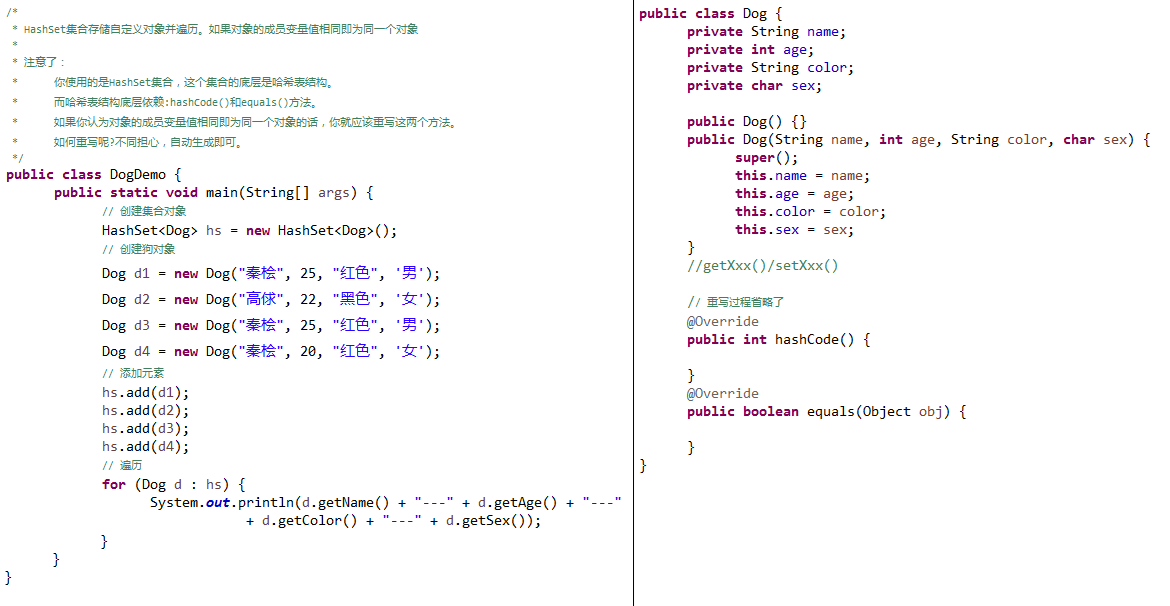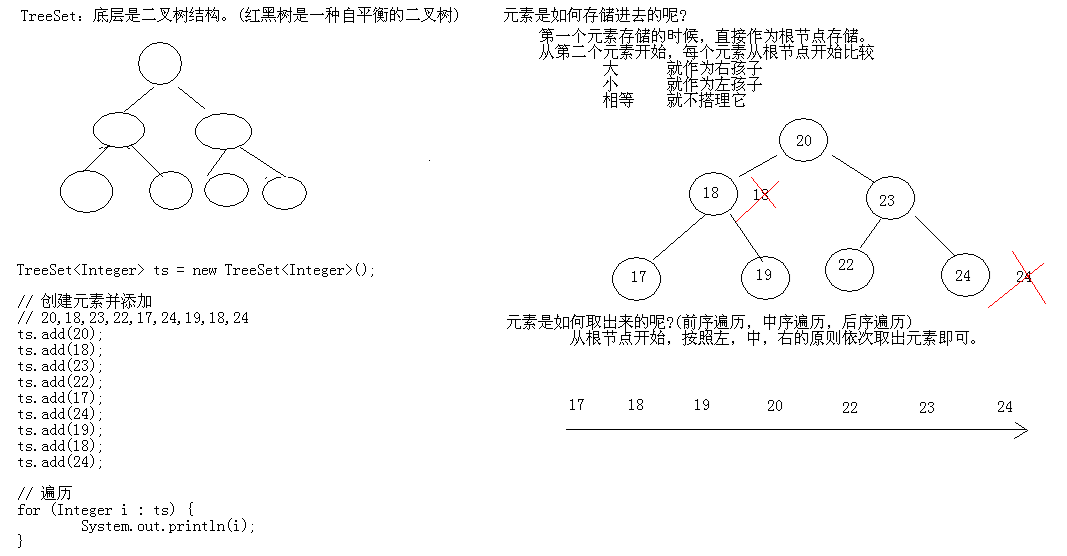集合(Set)
1. Set集合的特点
Set:不保存元素加入的顺序(存储顺序和取出顺序不一定一致),不能保存重复值
|-- HashSet:底层数据结构是哈希表(是一个元素为链表的数组)。集合中的元素根据哈希值进行排序(好像不是)。创建集合时可以指定集合的长度,长度不够时默认以75%的比例增加长度。
|-- TreeSet类:底层数据结构是红黑树(是一个自平衡的二叉树)。集合中的元素按照某种规则进行排序。创建集合不能指定集合的长度。
public class SetDemo {
public static void main(String[] args) {
// 创建集合对象
Set<String> set = new HashSet<String>();
// 创建并添加元素
set.add("hello");
set.add("java");
set.add("world");
set.add("java");
set.add("world");
// 增强for
for (String s : set) {
System.out.println(s);// java \n world \n hello \n
}
}
}
2. HashSet集合:它不保证 set 的迭代顺序;特别是它不保证该顺序恒久不变。此类允许使用 null 元素。
A:底层数据结构是哈希表(是一个元素为链表的数组)
B:哈希表底层依赖两个方法:hashCode()和equals()
执行顺序:
首先比较哈希值是否相同
相同:继续执行equals()方法
返回true:元素重复了,不添加
返回false:直接把元素添加到集合
不同:就直接把元素添加到集合
C:如何保证元素唯一性的呢?
由hashCode()和equals()保证的
D:开发的时候,代码非常的简单,自动生成即可。
E:HashSet存储字符串并遍历
F:HashSet存储自定义对象并遍历(对象的成员变量值相同即为同一个元素)
/*****************************************************************************************************************************************/
/*
* HashSet:存储字符串并遍历
* 问题:为什么存储字符串的时候,字符串内容相同的只存储了一个呢?
* 通过查看add方法的源码,我们知道这个方法底层依赖 两个方法:hashCode()和equals()。
* 步骤:
* 首先比较哈希值
* 如果相同,继续走,比较地址值或者走equals()
* 如果不同,就直接添加到集合中
* 按照方法的步骤来说:
* 先看hashCode()值是否相同
* 相同:继续走equals()方法
* 返回true: 说明元素重复,就不添加
* 返回false:说明元素不重复,就添加到集合
* 不同:就直接把元素添加到集合
* 如果类没有重写这两个方法,默认使用的Object()。一般来说不会相同。
* 而String类重写了hashCode()和equals()方法,所以,它就可以把内容相同的字符串去掉。只留下一个。
*/
public class HashSetDemo {
public static void main(String[] args) {
// 创建集合对象
HashSet<String> hs = new HashSet<String>();
// 创建并添加元素
hs.add("hello");
hs.add("world");
hs.add("java");
hs.add("world");
// 遍历集合
for (String s : hs) {
System.out.println(s);// world \n java \n hello \n
}
}
}
public class HashCodeDemo {
public static void main(String[] args) {
System.out.println("hello".hashCode());// 99162322
System.out.println("hello".hashCode());// 99162322
System.out.println("world".hashCode());// 113318802
}
}
HashSet集合的add()方法的源码解析:
interface Collection {
...
}
interface Set extends Collection {
...
}
class HashSet implements Set {
private static final Object PRESENT = new Object();
private transient HashMap<E,Object> map;
public HashSet() {
map = new HashMap<>();
}
public boolean add(E e) { //e=hello,world
return map.put(e, PRESENT)==null;
}
}
class HashMap implements Map {
public V put(K key, V value) { //key=e=hello,world
//看哈希表是否为空,如果空,就开辟空间
if (table == EMPTY_TABLE) {
inflateTable(threshold);
}
//判断对象是否为null
if (key == null)
return putForNullKey(value);
int hash = hash(key); //和对象的hashCode()方法相关
//在哈希表中查找hash值
int i = indexFor(hash, table.length);
for (Entry<K,V> e = table[i]; e != null; e = e.next) {
//这次的e其实是第一次的world
Object k;
if (e.hash == hash && ((k = e.key) == key || key.equals(k))) {
V oldValue = e.value;
e.value = value;
e.recordAccess(this);
return oldValue;
//走这里其实是没有添加元素
}
}
modCount++;
addEntry(hash, key, value, i); //把元素添加
return null;
}
transient int hashSeed = 0;
final int hash(Object k) { //k=key=e=hello,
int h = hashSeed;
if (0 != h && k instanceof String) {
return sun.misc.Hashing.stringHash32((String) k);
}
h ^= k.hashCode(); //这里调用的是对象的hashCode()方法
// This function ensures that hashCodes that differ only by
// constant multiples at each bit position have a bounded
// number of collisions (approximately 8 at default load factor).
h ^= (h >>> 20) ^ (h >>> 12);
return h ^ (h >>> 7) ^ (h >>> 4);
}
}
hs.add("hello");
hs.add("world");
hs.add("java");
hs.add("world");
/*****************************************************************************************************************************************/
/*
* 需求:存储自定义对象,并保证元素的唯一性
* 要求:如果两个对象的成员变量值都相同,则为同一个元素。
*
* 目前是不符合我的要求的:因为我们知道HashSet底层依赖的是hashCode()和equals()方法。
* 而这两个方法我们在学生类中没有重写,所以,默认使用的是Object类。
* 这个时候,他们的哈希值是不会一样的,根本就不会继续判断,执行了添加操作。
*/
public class HashSetDemo2 {
public static void main(String[] args) {
// 创建集合对象
HashSet<Student> hs = new HashSet<Student>();
// 创建学生对象
Student s1 = new Student("林青霞", 27);
Student s2 = new Student("柳岩", 22);
Student s3 = new Student("王祖贤", 30);
Student s4 = new Student("林青霞", 27);
Student s5 = new Student("林青霞", 20);
Student s6 = new Student("范冰冰", 22);
// 添加元素
hs.add(s1);
hs.add(s2);
hs.add(s3);
hs.add(s4);
hs.add(s5);
hs.add(s6);
// 遍历集合
for (Student s : hs) {
System.out.println(s.getName() + "---" + s.getAge());
}
}
}
public class Student {
private String name;
private int age;
public Student() {}
public Student(String name, int age) {
super();
this.name = name;
this.age = age;
}
//getXxx()/setXxx()
}
/*****************************************************************************************************************************************/

/*****************************************************************************************************************************************/
/*
* LinkedHashSet:底层数据结构由哈希表和链表组成。
* 哈希表保证元素的唯一性。
* 链表保证元素有序。(存储和取出是一致)
*/
public class LinkedHashSetDemo {
public static void main(String[] args) {
// 创建集合对象
LinkedHashSet<String> hs = new LinkedHashSet<String>();
// 创建并添加元素
hs.add("hello");
hs.add("world");
hs.add("java");
hs.add("world");
hs.add("java");
// 遍历
for (String s : hs) {
System.out.println(s);// hello \n world \n java \n
}
}
}
/*****************************************************************************************************************************************/
3. TreeSet集合:使用元素的自然顺序对元素进行排序,或者根据创建 set 时提供的 Comparator 进行排序,具体取决于使用的构造方法。(详情看API:TreeSet的构造方法)
A:底层数据结构是红黑树(是一个自平衡的二叉树)
B:保证元素的排序方式
a:自然排序(元素具备比较性)
让存储的元素所属的类实现自然排序接口:Comparable接口
b:比较器排序(集合具备比较性)
让集合构造方法接收Comparator的实现类对象
C:把代码看一遍即可
/*****************************************************************************************************************************************/
public class TreeSetDemo {
public static void main(String[] args) {
// 创建集合对象
// 自然顺序进行排序
TreeSet<Integer> ts = new TreeSet<Integer>(); // 存储的元素所属的类Integer以实现了Comparable<Integer>接口
// 创建元素并添加
// 20,18,23,22,17,24,19,18,24
ts.add(20);
ts.add(18);
ts.add(23);
ts.add(22);
ts.add(17);
ts.add(24);
ts.add(19);
ts.add(18);
ts.add(24);
// 遍历
for (Integer i : ts) {
System.out.println(i);
}
}
}
-------------------------------------------------------------------------------------------------------------------
TreeSet的add()方法的源码解析:
interface Collection {...}
interface Set extends Collection {...}
interface NavigableMap {
}
class TreeMap implements NavigableMap {
public V put(K key, V value) {
Entry<K,V> t = root;
if (t == null) {
compare(key, key); // type (and possibly null) check
root = new Entry<>(key, value, null);
size = 1;
modCount++;
return null;
}
int cmp;
Entry<K,V> parent;
// split comparator and comparable paths
Comparator<? super K> cpr = comparator;
if (cpr != null) {
do {
parent = t;
cmp = cpr.compare(key, t.key);
if (cmp < 0)
t = t.left;
else if (cmp > 0)
t = t.right;
else
return t.setValue(value);
} while (t != null);
}
else {
if (key == null)
throw new NullPointerException();
Comparable<? super K> k = (Comparable<? super K>) key;
do {
parent = t;
cmp = k.compareTo(t.key);
if (cmp < 0)
t = t.left;
else if (cmp > 0)
t = t.right;
else
return t.setValue(value);
} while (t != null);
}
Entry<K,V> e = new Entry<>(key, value, parent);
if (cmp < 0)
parent.left = e;
else
parent.right = e;
fixAfterInsertion(e);
size++;
modCount++;
return null;
}
}
class TreeSet implements Set {
private transient NavigableMap<E,Object> m;
public TreeSet() {
this(new TreeMap<E,Object>());
}
public boolean add(E e) {
return m.put(e, PRESENT)==null;
}
}
真正的比较是依赖于元素的compareTo()方法,而这个方法是定义在 Comparable里面的。
所以,你要想重写该方法,就必须是先 Comparable接口。这个接口表示的就是自然排序。
---------------------------------------------------------------------------------------------------------------------------------------------------------
TreeSet存储元素自然排序和唯一(元素不重复)的图解:

/*****************************************************************************************************************************************/
/*
* TreeSet存储自定义对象并保证排序和唯一。
* 要求:自然排序,按照年龄从小到大排序
* 成员变量值都相同即为同一个元素
* 如果Student不实现Comparable接口就会抛出以下异常
* java.lang.ClassCastException: cn.cast.Student cannot be cast to java.lang.Comparable
*/
public class TreeSetDemo2 {
public static void main(String[] args) {
// 创建集合对象
TreeSet<Student> ts = new TreeSet<Student>();
// 创建元素
Student s1 = new Student("l__", 27);
Student s2 = new Student("z__", 29);
Student s3 = new Student("w__", 23);
Student s4 = new Student("l__", 27); // 重此为复数据
Student s5 = new Student("l__", 22);
Student s6 = new Student("w__", 40);
Student s7 = new Student("f__", 22);
Student s8 = new Student("G__", 22);
// 添加元素
ts.add(s1);
ts.add(s2);
ts.add(s3);
ts.add(s4);
ts.add(s5);
ts.add(s6);
ts.add(s7);
ts.add(s8);
// 遍历
for (Student s : ts) {
System.out.println(s.getName() + "---" + s.getAge());
}
}
}
/*
* 如果一个类的元素要想能够进行自然排序,就必须实现自然排序接口存储的元素所属的类
*/
public class Student implements Comparable<Student> {
private String name;
private int age;
public Student() {}
public Student(String name, int age) {
super();
this.name = name;
this.age = age;
}
// getXxx()/setXxx()...
public int compareTo(Student s) {
// return 0;// 由源码可知,返回0说明元素相同,后面的元素不会被添加,所以只添加第一个。
// return 1;// 由源码可知,返回1说明新添加的元素是最大的,所以放在树的最右边,按添加顺序输出。
// return -1;// 由源码可知,返回-1说明新添加的元素是最小的,所以放在树的最左边,按添加倒序输出。
// 这里返回什么,其实应该根据我的排序规则来做
// 按照年龄排序,主要条件
int num = this.age - s.age;
// return num;// 如果年龄相同,就会返回0,并没有判断姓名。不符合要求。
// 次要条件
// 年龄相同的时候,还得去看姓名是否也相同。如果年龄和姓名都相同,才是同一个元素
int num2 = num == 0 ? this.name.compareTo(s.name) : num;
//String类实现了Comparable接口,按字典顺序比较两个字符
return num2;
}
}
/*****************************************************************************************************************************************/
/*
* 需求:请按照姓名的长度排序
*/
public class TreeSetDemo {
public static void main(String[] args) {
// 创建集合对象
TreeSet<Student> ts = new TreeSet<Student>();
// 创建元素
Student s1 = new Student("l", 27);
Student s2 = new Student("zhang", 29);
Student s3 = new Student("wangl", 23);
Student s4 = new Student("linqing", 29);
Student s5 = new Student("linqing", 22);
Student s6 = new Student("liu", 22);
Student s7 = new Student("wuqilong", 40);
Student s8 = new Student("linqingxia", 29);
// 添加元素
ts.add(s1);
ts.add(s2);
ts.add(s3);
ts.add(s4);
ts.add(s5);
ts.add(s6);
ts.add(s7);
ts.add(s8);
// 遍历
for (Student s : ts) {
System.out.println(s.getName() + "---" + s.getAge());
}
}
}
/*
* 如果一个类的元素要想能够进行自然排序,就必须实现自然排序接口
*/
public class Student implements Comparable<Student> {
private String name;
private int age;
public Student() {}
public Student(String name, int age) {
super();
this.name = name;
this.age = age;
}
// getXxx()/setXxx()...
public int compareTo(Student s) {
// 主要条件 姓名的长度
int num = this.name.length() - s.name.length();
// 姓名的长度相同,不代表姓名的内容相同
int num2 = num == 0 ? this.name.compareTo(s.name) : num;
// 姓名的长度和内容相同,不代表年龄相同,所以还得继续判断年龄
int num3 = num2 == 0 ? this.age - s.age : num2;
return num3;
}
}
如果很多地方使用Student类,要求的排序方式又不同,那就没办法实现了。这时就需要使用比较器排序,看下面的例子
/*****************************************************************************************************************************************/
/*
* 需求:请按照姓名的长度排序
*
* TreeSet集合保证元素排序和唯一性的原理
* 唯一性:是根据比较的返回是否是0来决定。
* 排序:
* A:自然排序(元素具备比较性)
* 让存储的元素所属的类实现自然排序接口 Comparable
* B:比较器排序(集合具备比较性)
* 让集合的构造方法接收一个比较器接口(Comparator)的子类对象
*/
public class TreeSetDemo {
public static void main(String[] args) {
// 创建集合对象
// TreeSet<Student> ts = new TreeSet<Student>(); //自然排序
// public TreeSet(Comparator<? super E> comparator)//比较器排序
// TreeSet<Student> ts = new TreeSet<Student>(new MyComparator());
// 如果一个方法的参数是接口,那么真正要的是接口的实现类的对象
// 而匿名内部类就可以实现这个东西,没必要单独写一个类,而且那样灵活度也不高。
// 而且比较器排序的匿名内部类实现,要比上面(自然排序)例子Student类实现Comparable接口要好,因为如果很多地方使用Student类,要求的排序方式又不同,那就没办法实现了。该种方式灵活度更高。
TreeSet<Student> ts = new TreeSet<Student>(new Comparator<Student>() {
@Override
public int compare(Student s1, Student s2) {
// 姓名长度
int num = s1.getName().length() - s2.getName().length();
// 姓名内容
int num2 = num == 0 ? s1.getName().compareTo(s2.getName())
: num;
// 年龄
int num3 = num2 == 0 ? s1.getAge() - s2.getAge() : num2;
return num3;
}
});
// 创建元素
Student s1 = new Student("l", 27);
Student s2 = new Student("zhang", 29);
Student s3 = new Student("wangl", 23);
Student s4 = new Student("linqing", 29);
Student s5 = new Student("linqing", 22);
Student s6 = new Student("liu", 22);
Student s7 = new Student("wuqilong", 40);
Student s8 = new Student("linqingxia", 29);
// 添加元素
ts.add(s1);
ts.add(s2);
ts.add(s3);
ts.add(s4);
ts.add(s5);
ts.add(s6);
ts.add(s7);
ts.add(s8);
// 遍历
for (Student s : ts) {
System.out.println(s.getName() + "---" + s.getAge());
}
}
}
----------------------
public class MyComparator implements Comparator<Student> {
public int compare(Student s1, Student s2) {
// int num = this.name.length() - s.name.length();
// this -- s1
// s -- s2
// 姓名长度
int num = s1.getName().length() - s2.getName().length();
// 姓名内容
int num2 = num == 0 ? s1.getName().compareTo(s2.getName()) : num;
// 年龄
int num3 = num2 == 0 ? s1.getAge() - s2.getAge() : num2;
return num3;
}
}
----------------------
public class Student {
private String name;
private int age;
public Student() {}
public Student(String name, int age) {
super();
this.name = name;
this.age = age;
}
// getXxx()/setXxx()...
}
/*****************************************************************************************************************************************/
4. 案例:
A:获取无重复的随机数
B:键盘录入学生按照总分从高到底输出
/*****************************************************************************************************************************************/
案例A:
/*
* 编写一个程序,获取10个1至20的随机数,要求随机数不能重复。
*
* 分析:
* A:创建随机数对象
* B:创建一个HashSet集合
* C:判断集合的长度是不是小于10
* 是:就创建一个随机数添加
* 否:不搭理它
* D:遍历HashSet集合
*/
public class HashSetDemo {
public static void main(String[] args) {
// 创建随机数对象
Random r = new Random();
// 创建一个Set集合
HashSet<Integer> ts = new HashSet<Integer>();
// 判断集合的长度是不是小于10
while (ts.size() < 10) {
int num = r.nextInt(20) + 1;
ts.add(num);
}
// 遍历Set集合
for (Integer i : ts) {
System.out.println(i);
}
}
}
/*****************************************************************************************************************************************/
案例B:
/*
* 键盘录入5个学生信息(姓名,语文成绩,数学成绩,英语成绩),按照总分从高到低输出到控制台
*
* 分析:
* A:定义学生类
* B:创建一个TreeSet集合
* C:总分从高到底如何实现呢?
* D:键盘录入5个学生信息
* E:遍历TreeSet集合
*/
public class TreeSetDemo {
public static void main(String[] args) {
// 创建一个TreeSet集合
TreeSet<Student> ts = new TreeSet<Student>(new Comparator<Student>() {
@Override
public int compare(Student s1, Student s2) {
// 总分从高到低
int num = s2.getSum() - s1.getSum();
// 总分相同的不一定语文相同
int num2 = num == 0 ? s1.getChinese() - s2.getChinese() : num;
// 总分相同的不一定数序相同
int num3 = num2 == 0 ? s1.getMath() - s2.getMath() : num2;
// 总分相同的不一定英语相同
int num4 = num3 == 0 ? s1.getEnglish() - s2.getEnglish() : num3;
// 姓名还不一定相同呢
int num5 = num4 == 0 ? s1.getName().compareTo(s2.getName()) : num4;
return num5;
}
});
System.out.println("学生信息录入开始");
// 键盘录入5个学生信息
for (int x = 1; x <= 5; x++) {
Scanner sc = new Scanner(System.in);
System.out.println("请输入第" + x + "个学生的姓名:");
String name = sc.nextLine();
System.out.println("请输入第" + x + "个学生的语文成绩:");
String chineseString = sc.nextLine();
System.out.println("请输入第" + x + "个学生的数学成绩:");
String mathString = sc.nextLine();
System.out.println("请输入第" + x + "个学生的英语成绩:");
String englishString = sc.nextLine();
// 把数据封装到学生对象中
Student s = new Student();
s.setName(name);
s.setChinese(Integer.parseInt(chineseString));
s.setMath(Integer.parseInt(mathString));
s.setEnglish(Integer.parseInt(englishString));
// 把学生对象添加到集合
ts.add(s);
}
System.out.println("学生信息录入完毕");
System.out.println("学习信息从高到低排序如下:");
System.out.println("姓名\t语文成绩\t数学成绩\t英语成绩");
// 遍历集合
for (Student s : ts) {
System.out.println(s.getName() + "\t" + s.getChinese() + "\t" + s.getMath() + "\t" + s.getEnglish());
}
}
}
public class Student {
private String name;// 姓名
private int chinese;// 语文成绩
private int math;// 数学成绩
private int english;// 英语成绩
public Student() {}
public Student(String name, int chinese, int math, int english) {
super();
this.name = name;
this.chinese = chinese;
this.math = math;
this.english = english;
}
//getXxx()/setXxx()...
}
/*****************************************************************************************************************************************/